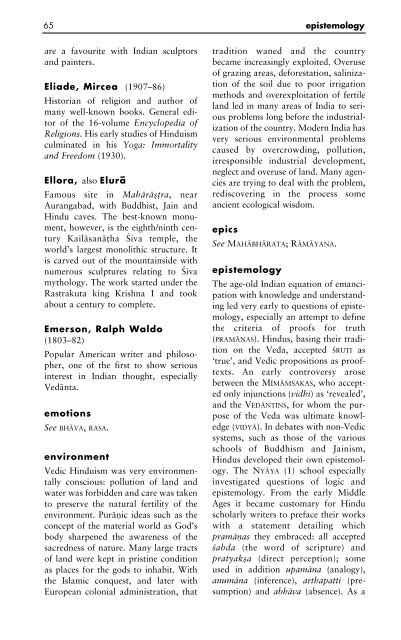A Concise Encyclopedia of Hinduism Klaus K Klostermaie
You also want an ePaper? Increase the reach of your titles
YUMPU automatically turns print PDFs into web optimized ePapers that Google loves.
65 epistemology<br />
are a favourite with Indian sculptors<br />
and painters.<br />
Eliade, Mircea (1907–86)<br />
Historian <strong>of</strong> religion and author <strong>of</strong><br />
many well-known books. General editor<br />
<strong>of</strong> the 16-volume <strong>Encyclopedia</strong> <strong>of</strong><br />
Religions. His early studies <strong>of</strong> <strong>Hinduism</strong><br />
culminated in his Yoga: Immortality<br />
and Freedom (1930).<br />
Ellora, also Elurä<br />
Famous site in Mahärä•flra, near<br />
Aurangabad, with Buddhist, Jain and<br />
Hindu caves. The best-known monument,<br />
however, is the eighth/ninth century<br />
Kailäsanäflha Ÿiva temple, the<br />
world’s largest monolithic structure. It<br />
is carved out <strong>of</strong> the mountainside with<br />
numerous sculptures relating to Ÿiva<br />
mythology. The work started under the<br />
Rastrakuta king Krishna I and took<br />
about a century to complete.<br />
Emerson, Ralph Waldo<br />
(1803–82)<br />
Popular American writer and philosopher,<br />
one <strong>of</strong> the first to show serious<br />
interest in Indian thought, especially<br />
Vedänta.<br />
emotions<br />
See BHÄVA, RASA.<br />
environment<br />
Vedic <strong>Hinduism</strong> was very environmentally<br />
conscious: pollution <strong>of</strong> land and<br />
water was forbidden and care was taken<br />
to preserve the natural fertility <strong>of</strong> the<br />
environment. Puräæic ideas such as the<br />
concept <strong>of</strong> the material world as God’s<br />
body sharpened the awareness <strong>of</strong> the<br />
sacredness <strong>of</strong> nature. Many large tracts<br />
<strong>of</strong> land were kept in pristine condition<br />
as places for the gods to inhabit. With<br />
the Islamic conquest, and later with<br />
European colonial administration, that<br />
tradition waned and the country<br />
became increasingly exploited. Overuse<br />
<strong>of</strong> grazing areas, deforestation, salinization<br />
<strong>of</strong> the soil due to poor irrigation<br />
methods and overexploitation <strong>of</strong> fertile<br />
land led in many areas <strong>of</strong> India to serious<br />
problems long before the industrialization<br />
<strong>of</strong> the country. Modern India has<br />
very serious environmental problems<br />
caused by overcrowding, pollution,<br />
irresponsible industrial development,<br />
neglect and overuse <strong>of</strong> land. Many agencies<br />
are trying to deal with the problem,<br />
rediscovering in the process some<br />
ancient ecological wisdom.<br />
epics<br />
See MAHÄBHÄRATA; RÄMÄYAŒA.<br />
epistemology<br />
The age-old Indian equation <strong>of</strong> emancipation<br />
with knowledge and understanding<br />
led very early to questions <strong>of</strong> epistemology,<br />
especially an attempt to define<br />
the criteria <strong>of</strong> pro<strong>of</strong>s for truth<br />
(PRAMÄŒAS). Hindus, basing their tradition<br />
on the Veda, accepted ŸRUTI as<br />
‘true’, and Vedic propositions as pro<strong>of</strong>texts.<br />
An early controversy arose<br />
between the MÏMÄßSAKAS, who accepted<br />
only injunctions (vidhi) as ‘revealed’,<br />
and the VEDÄNTINS, for whom the purpose<br />
<strong>of</strong> the Veda was ultimate knowledge<br />
(VIDYÄ). In debates with non-Vedic<br />
systems, such as those <strong>of</strong> the various<br />
schools <strong>of</strong> Buddhism and Jainism,<br />
Hindus developed their own epistemology.<br />
The NYÄYA (1) school especially<br />
investigated questions <strong>of</strong> logic and<br />
epistemology. From the early Middle<br />
Ages it became customary for Hindu<br />
scholarly writers to preface their works<br />
with a statement detailing which<br />
pramäæas they embraced: all accepted<br />
ÿabda (the word <strong>of</strong> scripture) and<br />
pratyak•a (direct perception); some<br />
used in addition upamäna (analogy),<br />
anumäna (inference), arthapatti (presumption)<br />
and abhäva (absence). As a


















